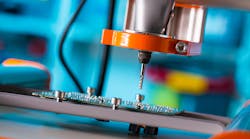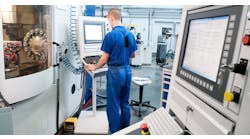CNC machining is critical to producing semiconductor components, primarily because of the precision control and repeatability that the control capabilities bring to the manufacturing hardware. Metal fabrication is no small feat, but computer numerical control (CNC) and advanced machining solutions make it possible, accurate, as well as efficient, resulting in better components and better semiconductor designs.
But just because CNC capabilities simplify the process doesn’t mean semiconductor manufacturing is any less complex. Many semiconductor development and assembly challenges come with the machining process.
Heading off these problems, or planning for them, will result in higher-quality semiconductor machining. Here's what you should know.
1. Keep the workplace clean — Cleanliness and organization in a machine shop can be crucial to productivity and high throughput. Worker safety is a huge concern right now, but that’s just one aspect of the overall situation.
Particle contamination, vacuum, and gas purity, and materials may promote or become contamination inside a machine shop. The related processes and equipment must be maintained and properly cleaned before machining begins, and sometimes amid operations too.
UV and light-based inspection tools can be used to find contaminants or locate runaway particles. Sensor-based monitoring solutions can be used to vent gas and other material sources. Proper cleaning regimens can be used to sanitize and remove contaminants from surfaces, equipment, tools and other areas.
Of course, all workers should follow proper safety and equipment protocols, including the use of personal protective gear. Moreover, a team or department should be established to directly handle the cleaning and maintenance of equipment, tools, and the shop floor.
2. Creating proper seals — For any semiconductor build seals are incredibly important, but even more so in in high-vacuum environments. Therefore, it’s necessary to conduct leak and surface tests before shipping out a component or part.
In the past, this is something that might have been handled off-site or by a third-party, but it’s more beneficial to have on-site testing stations. Helium-leak testing hardware can be a boon for semiconductor developers and is always a smart addition for any CNC machine shop.
When it comes to parts with complex geometry and patterns, seal tests can help bridge the gap between serious quality-control issues and flawless parts.
3. Reducing operator errors — Outside of major equipment failure or poor maintenance, most manufacturing and operational problems can be traced to human error. About 23% of all unplanned downtime in manufacturing stems from human error.
To improve the bottom line, it may be necessary to automate some of the duties human workers would otherwise handle. Advanced robots are an increasingly available replacement, and many of these are designed to work alongside human counterparts (collaborative robots, or "cobots") instead of replacing them.
When paired together, the robots gain intuition and problem-solving skills from humans while improving operational safety, productivity, and accuracy. A robot might carry or load bulky machining materials into the equipment, for example, directed by a human partner. Another bot might take care of repetitive tasks like cleaning or adjusting parts as it moves from one machine to another.
Cobots will not replace the human element in manufacturing, but they are bringing notable improvements.
4. Managing supplies — Most CNC projects are incredibly specific or intricate, in that parts are custom-made to match the specifications of a customer or partner. While this is excellent for business, it’s not ideal for managing supply and demand, particularly when those demands are dynamic and constantly changing.
One customer might go from ordering hundreds or thousands of parts to a fraction of their previous demands overnight. Another might upgrade its demands by requesting much higher quantities of finished parts. For these developments, it’s necessary to have a proper warehouse or storage location for excess supplies as well as a system for scaling down excess output.
The use of modern 3D printing, automation, and Artificial Intelligence can help manage these kinds of events accurately. Another less expensive solution is creating what’s known as “machine-ready blanks” or pre-machined pieces.
These are raw metal or material pieces that are cut to size, pre-ground and pre-milled. The idea is to lessen the work needed by reducing material prep and significantly reducing setup times. The parts are already pre-machined to near-exact specifications.
5. Establishing smarter processes — Predictive diagnostics and integrated intelligence are becoming widespread in manufacturing, and for a good reason: It involves installing sensors within machine hardware to monitor critical parameters, such as voltage, speed, position, temperature, and more. Data from the sensors is fed through an intelligent system that detects signs of failure and potential dips in quality.
What this means for a machining or any manufacturing operation is that problems are discovered early. As such, they’re dealt with a much earlier, more cost effectively, and in real-time. Quality is maintained while reducing downtimes and potential machining failures. Equipment also can be maintained, repaired, or replaced before major problems occur through a more proactive approach.
Keeping workers and the workplace clean, vetting seals and the quality of parts, reducing operational errors with cobots, managing supplies better and establishing smart, real-time diagnostics all are a part of becoming more efficient and aware in machine shops. These are also the keys to sustaining growth over time.
Megan Nichols is a STEM writer and blogger who writes on a wide range of scientific topics at schooledbyscience.com. Her recent work has included Adapting Machine Shops for Covid-19 Safety, Quick Tips for Machining Hard Materials, and 9 Popular Choices for EMI Shielding. Follow Megan on Twitter @nicholsrmegan.






